The first ever conference of the National Association of City Transportation Officials (NACTO) got underway on the campus of New York University this morning. The opening plenary features speeches from NACTO President and New York City DOT Commissioner Janette Sadik-Khan and US Department of Transportation Secretary Ray LaHood.
Sadik-Khan kicked things off. “We’re here to mark the flowering of urban design in our cities,” she said, “And to break down the institutional barriers that stand in our way.” NACTO, and the goal of this conference, is to give city transportation officials the tools, knowledge, and inspiration to do that.
“Newspaper headlines do not equal public opinion.”
— Sadik-Khan
Sadik-Khan laid out a convincing case for why cities that remake their streets with public plazas and ample space for biking, walking, sitting, and transit are needed now more than ever. Our cities, she said, will have to absorb 400 million more people by 2050. And with them will be the vast challenges of housing, public safety, and keeping climate change at bay.
For years, city officials have had to use federal transportation standards and guidelines that Sadik-Khan said are more suited to, “highways across the Great Plains, not to thriving cities.” (To help with that problem, NACTO announced the release of their new Urban Street Design Guide this morning, which should make a perfect companion to their already-in-use Urban Bikeway Design Guide.)
Sadik-Khan also acknowledged the political forces working against transportation innovations in cities. “Neither of our political parties seem to be able to utter the term ‘city’.” But the good news, she added, is that cities are not waiting. New York, Chicago, Washington D.C., San Francisco, and others are moving forward with creativity and collaboration.
Sadik-Khan urged city planners to focus on the importance of design and getting projects on the ground.
“It’s stunning that our streets have been in suspended animation for as long as they have. If you were running a business and you didn’t change your capital assets for 50 years, you’d be out of business. Our streets were designed for a different time and it’s long past time for an update.”
Far from being just about aesthetics or “tree hugging,” Sadik-Khan said remaking streets for people and reigning in the domination of private automobiles is about the bottom line and economic development. In one of her projects, a new plaza on a formerly wide street in the Dumbo neighborhood, led to a 172% rise in retail sales in its first 3 years after implementation (more than twice the growth of similar areas nearby). Her project that brought protected bikeways and other changes to 9th Avenue saw similar success with retail sales rising 50% in the three years since the bike lanes were installed.
made possible by:
- Planet Bike
- Lancaster Engineering
- Readers like you!
Sadik-Khan also addressed an issue that has loomed large during her tenure: controversy. About the “bike backlash” that has played out in New York City tabloid headlines, Sadik-Khan said, “Newspaper headlines do not equal public opinion.” When pushback does arise, she advised that it’s important to listen to that feedback, “But stay steady and don’t be stampeded by the headlines.”
She cited many independent public polls on her biggest projects that show a strong majority approve of the changes. “If this were an election, it would be a landslide.”
To build support for a new street paradigm, Sadik-Khan said it’s crucial to build demonstration projects. “You really need to start somewhere and it’s easier to build support if you can show people something.” Using paint, gravel, bollards, and other relatively cheap and easy to install materials, Sadik-Khan said it’s possible to “redefine spaces overnight.”
Sadik-Khan said her projects have not only improved the vitality and the economics of New York City, they have also lead to improved safety. The last five years have been the safest five years in New York City history, she said.
To keep implementing innovative projects, Sadik-Khan and other city leaders need help from the top. That’s where US DOT Secretary Ray LaHood has played a big role. In introducing LaHood, Sadik-Khan called him “A great friend to the cause of transportation reform.”
In his speech, LaHood spoke of “transformation” and the “next generation of transportation.”
In a private conversation before his speech, LaHood told City of Portland bike coordinator Roger Geller that for his generation, cars were king; but that’s changed. “It’s not all about cars anymore, it’s going to be about options… And we [the Obama Administration] have a responsibility to address that.”
The way LaHood explained it, the new generation of transportation planners, like the ones here at this conference, are just as important to the future of America as the generation that was responsible for the Interstate Highway System.
Looking ahead on the federal level, LaHood panned the recently adopted transportation bill. “The best part about MAP-21,” he said, “Is that it’s only for two years.”
The big debate now, in LaHood’s opinion, isn’t about what to build or which modes should have the most priority, it’s about, “How do we pay for it?” He called on the innovative thinkers in the room to come up with new transportation revenue streams.
(When asked about the future of the gas tax in a Q & A session after his speech, LaHood answered, “With 10 days to go before the election, and as a member of the Obama Administration, I’m not going to talk about taxes. Next question.”)
When it comes to building mega-highways and arterials versus the innovations in bikeways, plaza and transit planning we’re seeing in cities around the country, LaHood doesn’t waver about the future. “We are not going back,” he said in his speech this morning, “Once you go forward, once you make progress… We’re going forward!”
——
— This is my first dispatch from New York City. I’m here for a week to cover the NACTO Designing Cities conference and the city’s bike culture in general. This special reporting trip was made possible by Planet Bike, Lancaster Engineering, and by readers like you. Thank you! You can find all my coverage from this trip here.

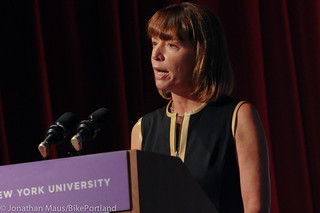
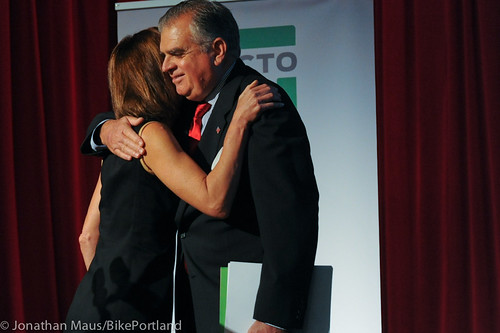
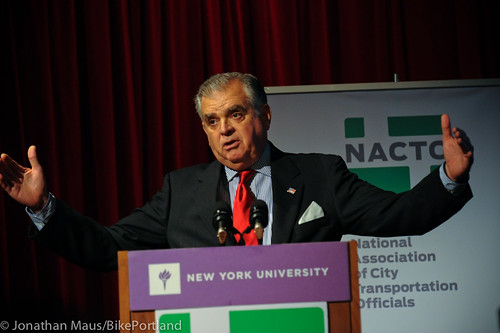
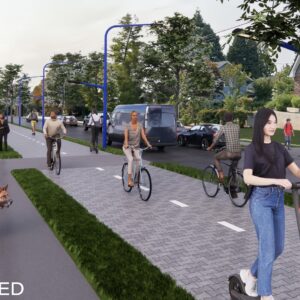
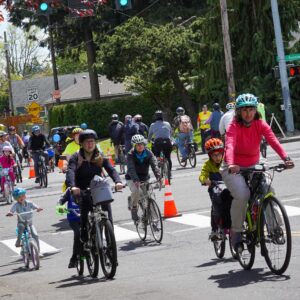

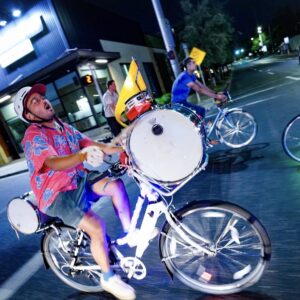
Thanks for reading.
BikePortland has served this community with independent community journalism since 2005. We rely on subscriptions from readers like you to survive. Your financial support is vital in keeping this valuable resource alive and well.
Please subscribe today to strengthen and expand our work.
So LaHood is off the CRC bandwagon, then? Great.
Thanks for the report, Jonathan.
LaHood seems a little inconsistent in that regard.
10 days before an election, is when we SHOULD be talking about taxes. Since it’s, y’know, one of the functions of government. The government that we’re electing. CALL ME CRAZY.
“Newspaper headlines do not equal public opinion.” Hear, hear!
I’d venture to say that newspaper headlines are the opposite of public opinion.
Newspaper revenue is based on sales we all know that controversy pushes sales.
Nothing is more controversial than a big bold headline that is antagonistic to what you already believe. The sad thing is that some readers are so clueless as to unquestioningly trust whatever the local controversy rag prints as truth.
Newspapers have become the extremist contrarian propaganda machine to the extent that any opinion that they spout should be considered suspect and false on face value.
“Our streets were designed for a different time and it’s long past time for an update.”
SO awesome to see this mindset at the top (as well as the action to back up the soundbytes).
Toronto has gone backwards, so let’s not delude ourselves into thinking that it can’t happen here.
dwainedibbly,
we can delude ourselves. That won’t happen here. There are simply too many people here who care about bike stuff to let it happen… And they are too smart and active in local politics and other venues of influence to let it happen.
Let’s see what happens in Clackamas County after the election.
All I’m saying is that we need to maintain vigilance.
Clackamas is Clackamas; to paraphrase Leonidas:
“THIS IS PORTLAND!!”